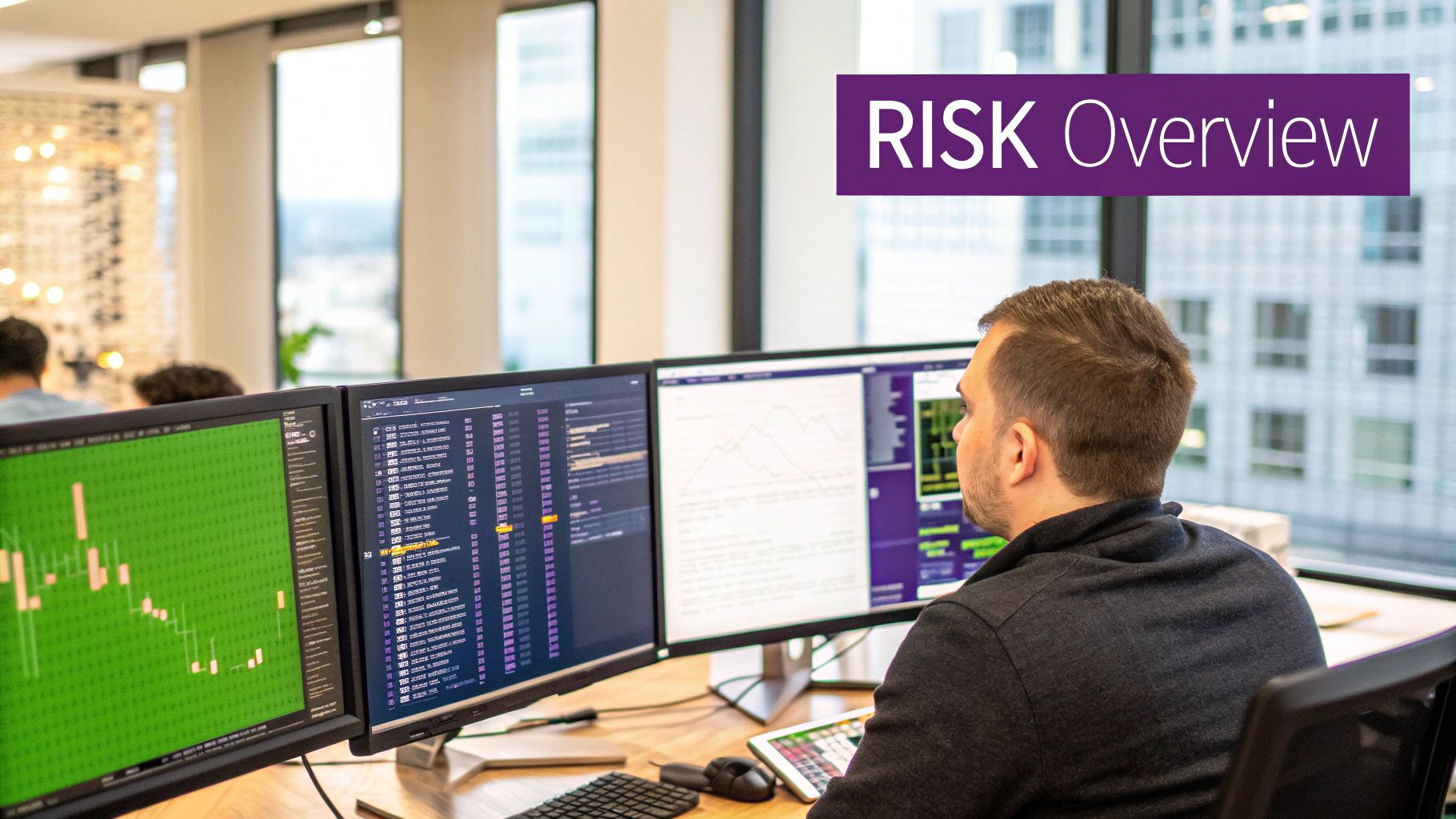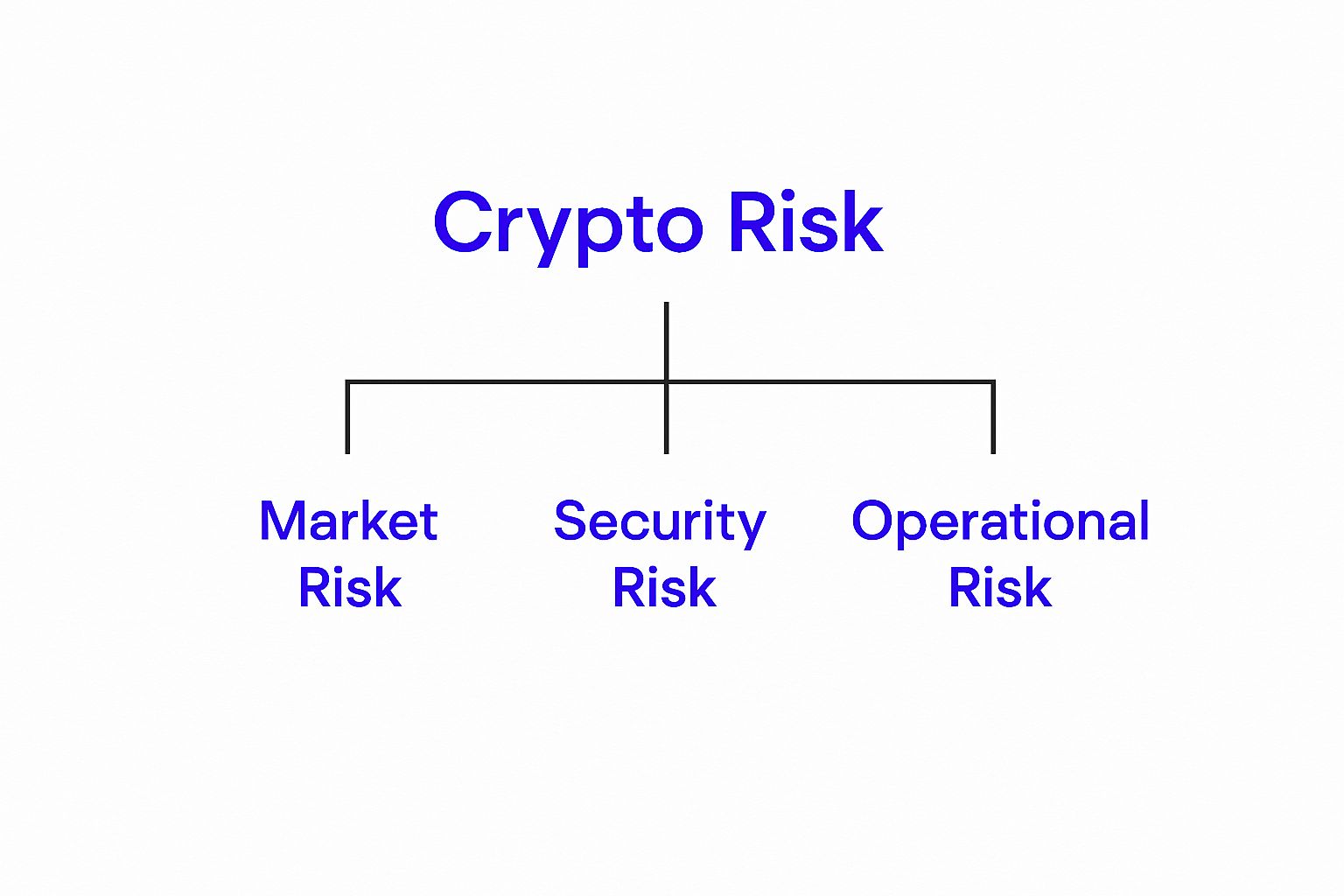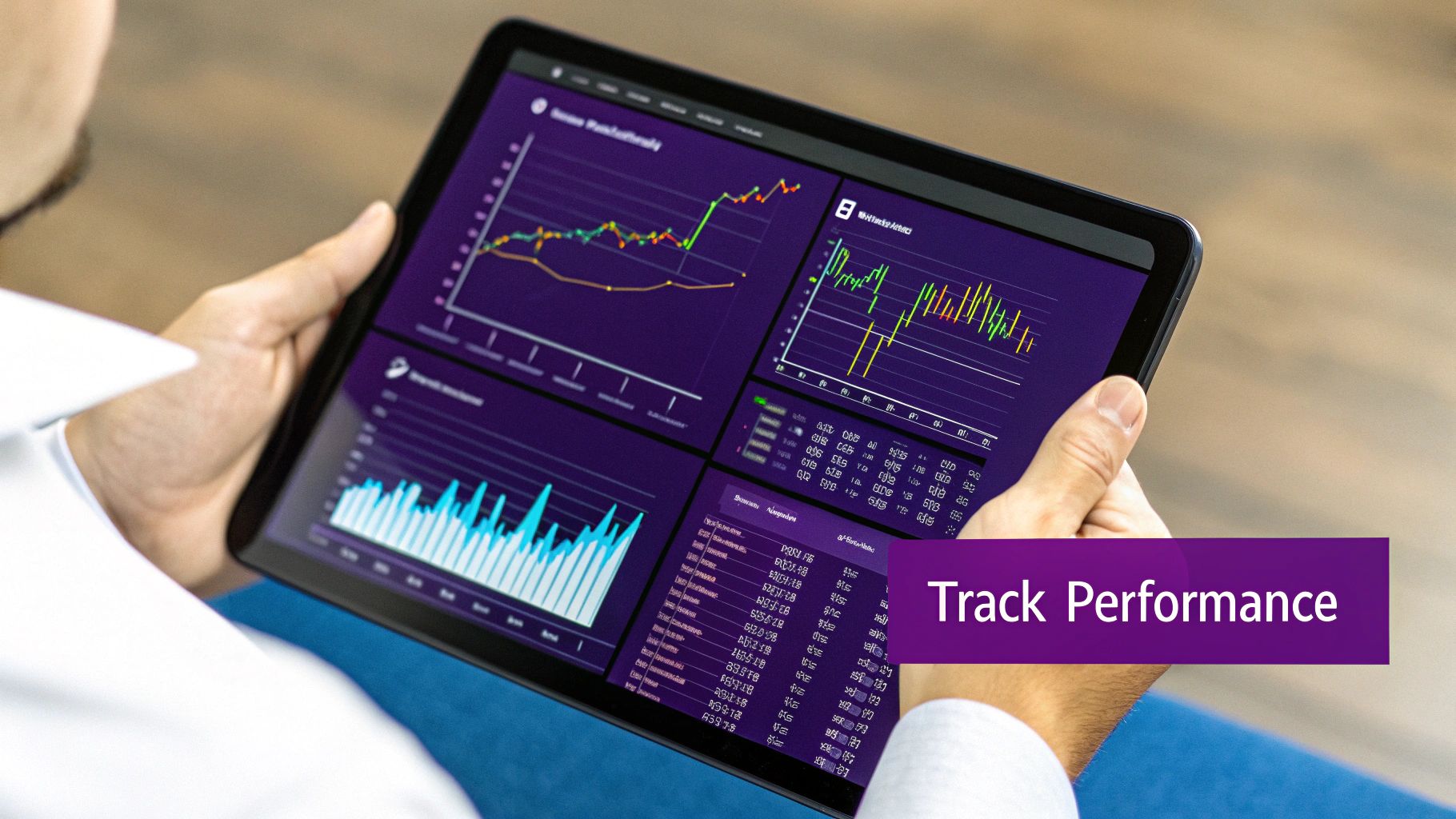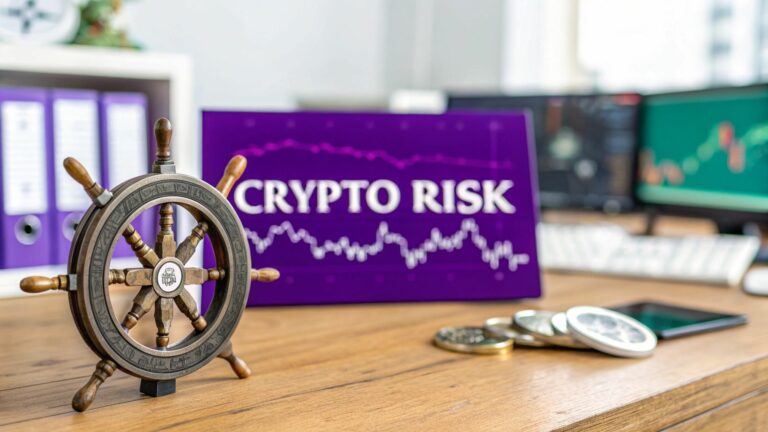Dipping your toes into the world of digital assets often feels like casting off into a vast, unpredictable ocean. The potential treasures are immense, but so are the storms. This is where effective crypto risk management comes in—it’s not about avoiding the high seas, but about becoming a skilled captain who knows how to read the weather, navigate threats, and keep your ship sailing toward your destination.
Navigating Crypto's Unpredictable Waters

This guide isn’t here to tell you to stay in the harbor. It’s here to hand you the nautical charts and teach you the skills to navigate safely. Think of crypto risk management less as a barrier and more as your most essential tool for long-term survival. Without it, you’re just gambling. With it, you become a disciplined investor.
The core principles aren't entirely foreign. Before you can tackle the unique challenges of crypto, it pays to have a solid grasp of traditional investment strategies. This comprehensive guide on managing overall investment risk is a fantastic starting point, as it breaks down concepts that apply to any asset class you might consider.
Building Your Strategic Framework
A solid risk management framework is about understanding and preparing for specific threats, not just hoping for the best. It requires you to think through multiple potential points of failure before they ever happen.
The big idea here is simple: You don’t predict the future, you prepare for it. A robust risk plan allows your portfolio to survive the unexpected, giving you the staying power to seize opportunities when others are forced to retreat.
This means putting together a clear, step-by-step roadmap that addresses the primary dangers you'll face on your journey. The goal is to build a resilient strategy that can handle whatever the market throws at it. Key components include:
- Market Risk: This is the most obvious threat—the dramatic, heart-stopping price swings crypto is famous for. It’s about getting a handle on volatility, market sentiment, and the larger economic forces at play.
- Security Risk: In the digital world, this is the modern equivalent of fighting off pirates. It covers everything from exchange hacks and wallet compromises to clever phishing scams designed to drain your funds.
- Operational Risk: These are the “behind-the-scenes” dangers. Think of an exchange suddenly freezing withdrawals, a smart contract bug being exploited, or even a simple, costly human error on your part.
By breaking down the threats into these categories, you can stop using a one-size-fits-all approach and start applying targeted solutions. To see how established platforms bake security into their DNA, learning about the mission of a company like vTrader offers a great look into what it takes to build a secure trading environment. We’ll dig into each of these risks, giving you a real-world playbook for protecting your portfolio.
The Three Pillars of Cryptocurrency Risk
If you want to build an effective defense, you first need to understand the battlefield. In the world of crypto, risk isn't a single, looming threat. It's a mix of distinct dangers, and each one demands a specific response. Real crypto risk management starts when you break these threats down into three core pillars.
This diagram clearly lays out the main categories of risk you'll be up against.

By separating Market, Security, and Operational risks, you can ditch the one-size-fits-all approach and start using targeted strategies that actually work.
Pillar 1: Market Risk
This is the one everyone knows about—the wild price swings that grab headlines. Market risk is simply the chance that your investment will lose value because of broad market movements.
In crypto, two elements really drive this:
- Volatility: Think of a calm lake versus a stormy ocean. A utility stock might be the calm lake, with slow, predictable changes. Bitcoin, however, is the stormy sea. Its price can easily jump or dive by 10-20% in a single day based on a piece of news, a regulatory rumor, or a sudden shift in trader mood.
- Liquidity Risk: This is the danger that you can't sell your crypto quickly without tanking the price. For giants like Ethereum, liquidity is rarely an issue; there are always buyers and sellers ready to trade. But if you’re trying to offload a large bag of a new, obscure altcoin, you might find there aren't enough buyers, causing the price to collapse under your sell order.
Managing market risk isn't about perfectly timing the tops and bottoms. It’s about having a game plan to survive the storms, like setting stop-loss orders or diversifying your portfolio so one bad actor doesn't sink your ship.
Pillar 2: Security Risk
The second pillar, security risk, covers the external threats trying to steal your funds. Unlike market risk, which is a byproduct of the market itself, these are direct attacks on your holdings or the platforms you trust.
These threats usually pop up in a few common ways:
- Exchange Hacks: Centralized exchanges are giant honey pots, holding billions in assets that make them irresistible targets for hackers. A successful breach can mean a total loss of any funds you had on that platform.
- Smart Contract Exploits: The world of DeFi runs on smart contracts—code that executes automatically. But if there's a flaw in that code, an attacker can exploit it to drain millions from a lending pool or decentralized exchange.
- Phishing and Scams: These attacks are aimed squarely at you. Scammers use fake emails, copycat websites, and bogus social media DMs to trick you into giving up your private keys or seed phrases—the digital keys to your entire crypto kingdom.
Security breaches are a constant, serious threat. In fact, these incidents often spike during bull markets, when soaring prices and high trading volumes make platforms even juicier targets. Early 2025 has already seen breach values match all of 2024, driven by a staggering $1.5 billion theft. Major exchanges like HTX, OKX, and KuCoin have all been hit, showing that even the big players have vulnerabilities.
Pillar 3: Operational Risk
This is the pillar everyone forgets about, yet it can be the most devastating. Operational risk comes from failures in your own processes, systems, or simple human mistakes. These are the "unforced errors" that can be just as costly as a market crash or a hack.
Operational risk is the silent portfolio killer. It’s not the dramatic external attack but the quiet internal failure—a lost password, a frozen exchange account, or a mistaken transaction—that can wipe out your gains.
Here are a few ways this risk shows up:
- Counterparty Risk: This is the risk that the other side of your deal won't hold up their end. For example, a centralized exchange you use could suddenly go bankrupt or freeze withdrawals, locking you out of your own funds.
- Human Error: This is by far the most common operational risk. Sending crypto to the wrong address, losing the hardware wallet holding your life savings, or forgetting a critical password can lead to a permanent, irreversible loss. There’s no "forgot password" button for a private key.
- Regulatory Risk: A sudden government ban or harsh new rules can crush an asset's value overnight or make it impossible for you to trade. This risk is tied to the unpredictable actions of policymakers, not market fundamentals.
Getting a firm grip on these three pillars is the foundation of any solid crypto risk management plan. For anyone looking to go deeper, the vTrader Academy offers structured lessons on these and other essential trading topics.
Your Defensive Toolkit for Mitigating Risk

Knowing the different types of risk is like reading your opponent's playbook. But reading isn't enough—now it's time to execute your defensive strategy. Real crypto risk management is an active game, demanding a solid toolkit of practices built to shield your capital from wild market swings, security breaches, and simple operational mistakes.
This isn't about generic advice. Let's dig into the hands-on techniques for portfolio building, trade execution, and asset security that you can put to work today.
Strategic Asset Diversification
The first tool in any investor's kit is diversification. But in crypto, this means more than just grabbing a few different coins and crossing your fingers. True diversification is about deliberately reducing correlation—that is, the tendency for all your assets to tank at the same time.
When the market really gets hit, it's not unusual to see Bitcoin, Ethereum, and the big-name altcoins all fall in unison. A genuinely diversified crypto portfolio spreads your money across assets with different missions, market caps, and even foundational technologies.
A classic rookie error is what some call "diworsification"—scooping up dozens of similar, high-risk altcoins. This doesn't hedge your risk; it just amplifies your exposure to a single, volatile slice of the market. The real goal is to own assets that don't always dance to the same tune.
To get this right, think about it in layers:
- Across Crypto Assets: Spread your capital between the established giants like Bitcoin, major smart contract platforms like Ethereum, and maybe a smaller, speculative position in a specific sector like gaming or AI.
- Beyond Crypto: For true portfolio resilience, look outside of crypto entirely. Holding assets like stocks, bonds, or commodities can be one of your strongest defenses against a brutal, system-wide crypto winter because they are completely uncorrelated to the crypto market.
Executing with Automated Orders
Emotion is the sworn enemy of smart trading. Fear makes you panic-sell at the bottom, while greed convinces you to hold on too long, watching profits vanish. This is where automated orders become your best friend for disciplined risk management.
A stop-loss order is your financial safety net. You simply set a price below the current market value where your asset will automatically sell. If the market suddenly plummets, the order kicks in and caps your losses before you have time to make a panicked, emotional decision.
On the flip side, a take-profit order is how you lock in your wins. You set a target price above what you paid, and the asset sells automatically once it hits that number. This instills discipline, making sure you actually realize your gains instead of just watching them evaporate in the next market reversal.
Fortifying Your Digital Vault
All the brilliant market strategy in the world means nothing if your assets get stolen. In a world where hacks and sophisticated scams are constant threats, bulletproof security isn't optional. Think of it as putting your gold in a bank vault instead of leaving it on the kitchen table.
Your security toolkit absolutely must include these essentials:
- Hardware Wallets: Often called "cold storage," these are physical devices that keep your private keys completely offline. By disconnecting your keys from the internet, you make it virtually impossible for remote hackers to get to them. Any crypto you aren't actively trading belongs in a hardware wallet.
- Multi-Factor Authentication (MFA): Always enable MFA on every single exchange account you own, preferably using an authenticator app, not just SMS texts. This adds a critical second barrier, requiring a code from your physical device before anyone can get in—even if they’ve somehow stolen your password.
- Phishing Awareness: Scammers are experts at creating fake websites and sending emails that look identical to the real thing. Always, always double-check URLs before you type in your credentials, and be extremely suspicious of any "urgent" message asking you to verify your account or claim a prize.
To make these concepts even clearer, here’s a quick rundown of how these strategies stack up.
Crypto Risk Mitigation Techniques at a Glance
This table breaks down the most common risk management techniques, what they're for, and what kind of trouble they help you avoid.
| Strategy | Primary Purpose | Risk Addressed | Best For |
|---|---|---|---|
| Stop-Loss Orders | To automatically sell an asset at a preset price. | Market Risk, Volatility Risk | Active traders wanting to limit downside on a specific position. |
| Take-Profit Orders | To automatically sell an asset at a profit target. | Emotional Risk, Opportunity Risk | Traders who want to enforce discipline and secure gains. |
| Diversification | To spread capital across uncorrelated assets. | Concentration Risk, Market Risk | All investors looking to build a resilient, long-term portfolio. |
| Hardware Wallets | To store private keys offline and away from hacks. | Security Risk, Custodial Risk | Long-term holders securing significant amounts of crypto. |
| MFA | To add a second layer of account verification. | Security Risk, Operational Risk | Everyone. This is a non-negotiable for any online account. |
| Staking/Yield Farming | To earn passive income on your holdings. | Opportunity Risk, Inflation Risk | Investors comfortable with smart contract risk to earn rewards. |
| Due Diligence | To thoroughly research a project before investing. | Project Risk, Scams | All investors. Never invest in what you don't understand. |
Putting these defensive tools into practice is what separates a passive crypto holder from a proactive manager of their own financial destiny. It's about taking control in a market that often feels uncontrollable.
Hedging Strategies with Crypto Derivatives
If you’ve moved past the basics of diversification and stop-loss orders, it’s time to look at the more sophisticated tools in a trader's risk management kit. This is where financial derivatives come into play, and they’re a game-changer for anyone serious about protecting their portfolio.
Think of derivatives as specialized instruments for navigating the wild swings of the crypto market. They give you a way to hedge against specific outcomes with surgical precision, often without having to sell your core assets. It’s like buying an insurance policy for your portfolio—you pay a small, known premium to shield yourself from a much larger, unknown loss.
Using Futures to Protect Against Downturns
A futures contract is a straightforward agreement: you lock in a price to buy or sell an asset at a specific date down the road. For risk management, you can use them to essentially bet against your own holdings.
It sounds strange, but it’s a brilliant defensive play. Imagine you’re holding a good amount of Bitcoin but have a hunch the market might dip in the short term. Instead of selling your BTC and risking a missed opportunity if it unexpectedly rallies, you could open a short Bitcoin futures position.
- If the market tanks: Your futures contract turns a profit, offsetting the paper losses on the Bitcoin you're holding.
- If the market soars: You'll lose a bit on the futures contract, but the gains on your actual Bitcoin holdings will likely cancel that out, or even exceed it.
Either way, you've cushioned your portfolio from the shocks of short-term volatility. This gives you peace of mind and lets you stick to your long-term strategy without panicking.
Creating a Price Floor with Options
For even more flexibility, traders turn to options. A put option gives you the right—but not the obligation—to sell an asset at a predetermined price (the "strike price") before a certain date. This is the ultimate tool for setting a hard floor on your potential losses.
Think of a put option like a concert ticket with a guaranteed buy-back price. If the show is a flop (market crashes), you can sell your ticket back for the guaranteed price. If the show is a massive hit (market soars), you just tear up the buy-back offer and sell your ticket for way more to someone else.
Let's say you own Ethereum and you're worried about it dropping below $3,000. You could buy a put option with a $3,000 strike price. This guarantees you a buyer at that price, no matter how low the market actually goes. You’ve effectively capped your downside.
These tools are no longer niche; they've exploded in popularity and are transforming how traders manage risk. The average daily volume for crypto derivatives on platforms like CME Group rocketed to 198,000 contracts in Q1 2025, representing a massive $11.3 billion in notional value. New products are hitting the market all the time, making it easier than ever to hedge your positions.
Of course, hedging is just one piece of the puzzle. While you’re actively managing risk with derivatives, you shouldn’t neglect opportunities to earn passive returns. Strategies like crypto staking on vTrader can complement your hedging by generating yield on the assets you’re holding for the long haul. Combining active defense with passive income is how you build a truly resilient and well-rounded portfolio.
Adopting an Institutional Risk Framework

As crypto grows up, the old lines between casual trading and professional investing are starting to blur. If you're looking to elevate your own strategy, it's worth borrowing a few pages from the playbook of large financial institutions. These players don’t just buy and sell; they build formal crypto risk management frameworks to protect their capital for the long haul.
This professional mindset goes far beyond simple buy-and-hold tactics. It's about a disciplined, structured approach that accounts for a whole spectrum of threats—from a sudden regulatory change to an exchange suddenly going bust. For individual investors, thinking like an institution can be the key to moving from pure speculation to disciplined wealth building.
This shift isn't just a theory; it's happening right now. Recent findings show that by 2025, 78% of global institutional investors now use formal risk management frameworks for their crypto holdings. That’s a massive jump from just 54% in 2023, signaling that crypto is maturing from a wild west into a professionally managed asset class. You can dig into more of these institutional crypto adoption trends on CoinLaw.io.
Mastering Counterparty and Custodial Risk
A bedrock principle of any institutional framework is a ruthless assessment of counterparty risk. Simply put, this is the risk that the other party in your transaction—an exchange, a custodian, or a lending platform—won't be able to hold up their end of the deal. Before an institution parks millions on an exchange, you can bet they've done a deep dive on that platform’s financial health, security setup, and operational track record.
This leads us straight to the next critical piece of the puzzle: custody. An institutional-grade custody solution is worlds apart from your average retail wallet or exchange account.
For an institution, custody isn't just about holding coins. It’s about segregated accounts, multi-signature controls for withdrawals, and regular, independent audits. The entire system is built on the assumption that threats, both internal and external, are a constant reality.
You can bring this same mindset to your own trading. Acknowledge that not all exchanges are built the same. Scrutinize their security history, look into their insurance policies, and check for public audits before you deposit any serious amount of capital.
Navigating the Regulatory Maze
Big institutions don’t just react to regulations; they have entire compliance departments dedicated to anticipating them. In crypto, this conversation almost always circles back to Know Your Customer (KYC) and Anti-Money Laundering (AML) rules. These aren't just bureaucratic hoops to jump through—they're fundamental risk tools that help keep illicit funds from blowing up a platform.
By choosing exchanges that take KYC/AML seriously, you're indirectly protecting yourself. These platforms are far less likely to face sudden regulatory crackdowns or frozen assets, adding a welcome layer of stability to your setup.
As the market continues to evolve, everyone needs to keep an eye on official guidance. For instance, recent reports have highlighted regulators urging banks to address crypto liquidity risks, which shows just how much traditional finance principles are bleeding into the digital asset world.
Institutional frameworks also sweat the small stuff that many retail traders ignore. For example, they actively monitor on-chain transaction costs as part of their risk strategy. Sky-high network fees can eat into profits and mess up your execution, which is why a simple tool like an ETH gas tracker is a smart way to manage a small but meaningful operational risk. Adopting an institutional framework is really about building a professional, multi-layered defense for your portfolio.
Automating Your Risk Strategy with vTrader
Let's be realistic—trying to manually execute a perfect risk management strategy in crypto is a recipe for burnout. The market is a 24/7 machine, and the threats never take a break. This is where we humans hit a wall. No one can possibly watch every price move or news alert without getting exhausted or emotional. That’s why automation isn't just a convenience; it's the only sensible way to apply your rules without fail.
Think of a tool like vTrader as your own tireless risk manager. It takes all the defensive strategies we've discussed and puts them into action automatically, in real time. It effectively removes emotion from the picture, making sure your plan is followed to the letter, whether you're at your desk or fast asleep.
Enforcing Market Risk Rules with Trading Bots
The most immediate win from automation is getting a handle on market risk. We’ve talked about how crucial stop-loss and take-profit orders are, but placing them by hand is often too slow. Worse, it opens the door to second-guessing when things get volatile.
Automation transforms your risk management plan from a set of good intentions into a system of unbreakable rules. It’s the difference between hoping you’ll make the right move and guaranteeing it happens.
This is exactly what vTrader’s trading bots are built for. You can program them with your exact entry points, profit goals, and—most importantly—your absolute maximum loss. The bot then executes those orders instantly, without a shred of fear or greed. It protects your capital from sudden nosedives and locks in gains when your targets are hit. This kind of disciplined execution is the bedrock of solid crypto risk management.
Maintaining Balance and Diversification Automatically
Another cornerstone of smart risk strategy is diversification. The problem is, a perfectly balanced portfolio today can become dangerously lopsided tomorrow as some assets rocket upwards while others lag. The process of rebalancing—selling off some winners to buy more of the underperformers—is a chore that many traders simply forget to do.
vTrader's portfolio automation tools take this tedious task off your plate. Here’s how it works:
- Automated Rebalancing: You define your ideal portfolio mix, like 50% Bitcoin, 30% Ethereum, and 20% Altcoins. The system then keeps an eye on your holdings and automatically rebalances them to stick to those targets.
- Strategic Allocation: This forces you into a disciplined "sell high and buy low" cycle, preventing any single hot asset from exposing your entire portfolio to too much risk.
This hands-off approach ensures your portfolio stays aligned with your long-term goals without you having to constantly tinker with it.
Managing Operational and Security Risk
Finally, automation is a huge help in reducing the operational risks that come with managing accounts across multiple platforms. Juggling different exchange logins and wallets is not only a headache, but it also increases your chances of making a mistake or falling for a security threat.
vTrader helps you consolidate everything using secure API connections. By linking your external exchange accounts to your vTrader dashboard, you get a bird's-eye view of your entire crypto net worth from one secure place. This centralized hub means you're logging into fewer platforms, which immediately shrinks your exposure to phishing scams and other security holes.
From executing trades on autopilot to keeping your portfolio diversified and centralizing oversight, automation is easily the most powerful tool you have for building a truly robust crypto risk management system. It delivers the kind of discipline and consistency that human traders, on their own, just can't match.
Got Questions? We’ve Got Answers.
Jumping into crypto risk management can feel like learning a new language. Let's break down some of the most common questions traders ask when they're just getting their sea legs.
What’s the Single Biggest Risk for New Traders?
Hands down, the most critical risk for anyone new to the game is market risk, and the best way to tackle it is with smart position sizing. Forget about complex hacks or fancy derivatives for a moment. The real, immediate danger is throwing too much money into a market known for its wild price swings.
The golden rule here is as simple as it gets: never invest more than you’re truly willing to lose. Get a feel for the market's pulse by starting with smaller positions. Before you even place a trade, you need a rock-solid plan for when to take profits and, more importantly, when to cut your losses. That discipline is what separates traders who last from those who get wiped out.
How Much of My Crypto Should I Keep in a Hardware Wallet?
It's a common best practice to move any crypto you aren't actively trading into a hardware wallet, which is also called cold storage. A good way to think about it is this: your hardware wallet is your vault, your high-security savings account. The funds you keep on an exchange are like your checking account, ready for day-to-day use.
Keep your long-term holds offline in a hardware wallet. The only funds that should stay on a reputable exchange are what you need for your immediate trading plans. This massively cuts down your exposure to platform-specific nightmares like hacks or unexpected account freezes.
Can I Just Diversify My Portfolio and Call It a Day?
Not quite. While diversification is a cornerstone of sound investing, it's not a silver bullet. Spreading your capital across different coins is a smart move, but it won't make you invincible, especially when the entire market takes a nosedive.
During a crypto bear market, you’ll notice that most assets become highly correlated—they all bleed value at the same time. A truly tough portfolio needs more than just diversification. It combines several tactics:
- Setting up automated stop-loss orders to protect your downside.
- Moving the bulk of your assets into the safety of cold storage.
- Doing your homework to understand the unique risks tied to each coin you hold.
Are Stablecoins Totally Risk-Free?
Absolutely not. Stablecoins are built to dodge price volatility, but they come with their own unique bag of risks that you need to be aware of. The biggest ones are counterparty risk (is the coin really backed 1-to-1 by actual dollars in a bank?) and smart contract risk (are there hidden bugs in the code that a hacker could exploit?). Always dig into a stablecoin's structure and backing before you park your capital in it.
For a deeper dive into these topics, feel free to check out the official vTrader FAQ page for more detailed answers.
Ready to trade with a plan instead of just a prayer? vTrader equips you with advanced tools and automated features to execute a disciplined risk management strategy, minus the emotional chaos—all with zero trading fees. Open your free account today and start trading smarter.

Steve Gregory is a lawyer in the United States who specializes in licensing for cryptocurrency companies and products. Steve began his career as an attorney in 2015 but made the switch to working in cryptocurrency full time shortly after joining the original team at Gemini Trust Company, an early cryptocurrency exchange based in New York City. Steve then joined CEX.io and was able to launch their regulated US-based cryptocurrency. Steve then went on to become the CEO at currency.com when he ran for four years and was able to lead currency.com to being fully acquired in 2025.


